
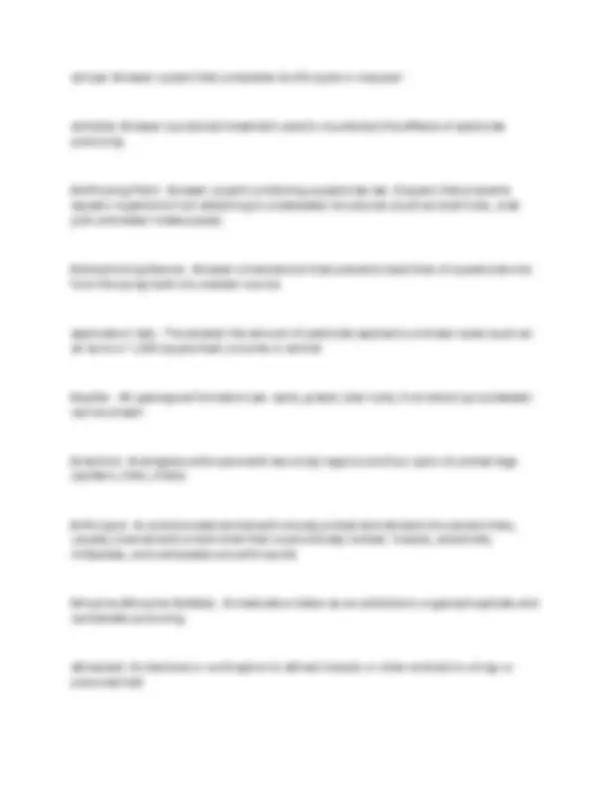
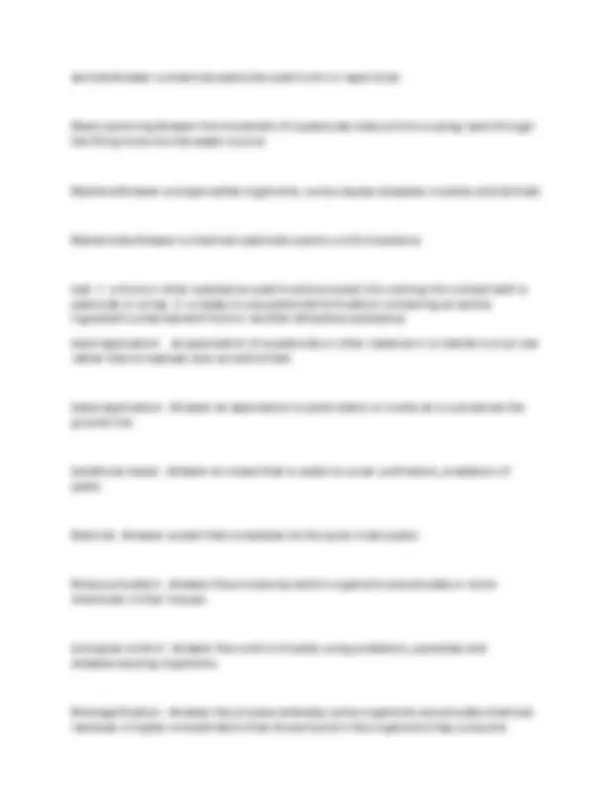

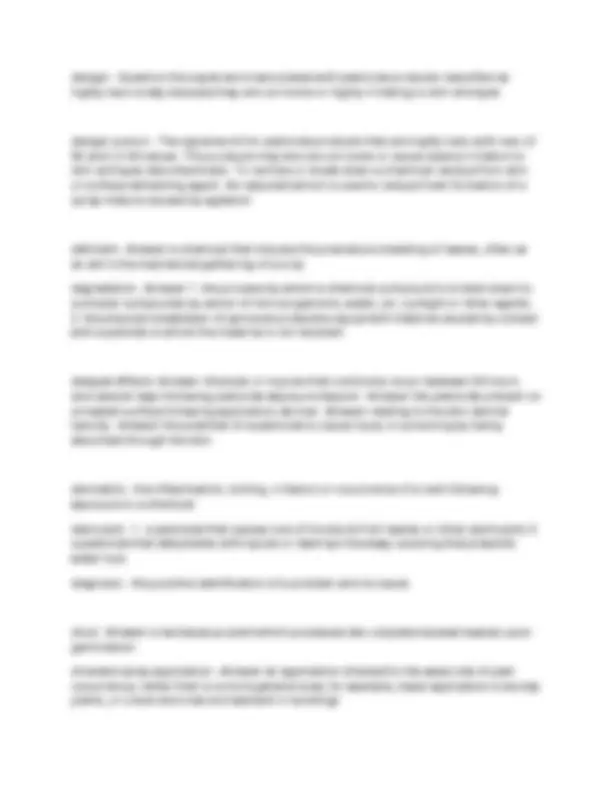
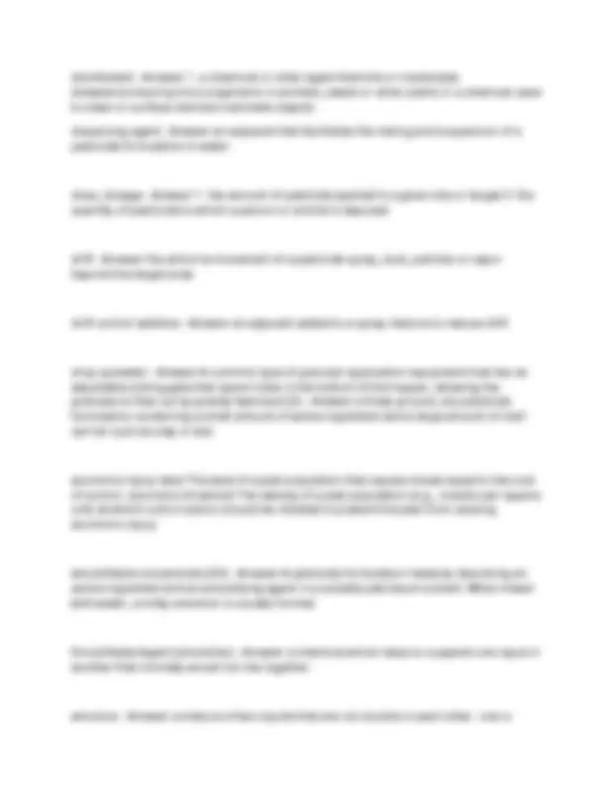
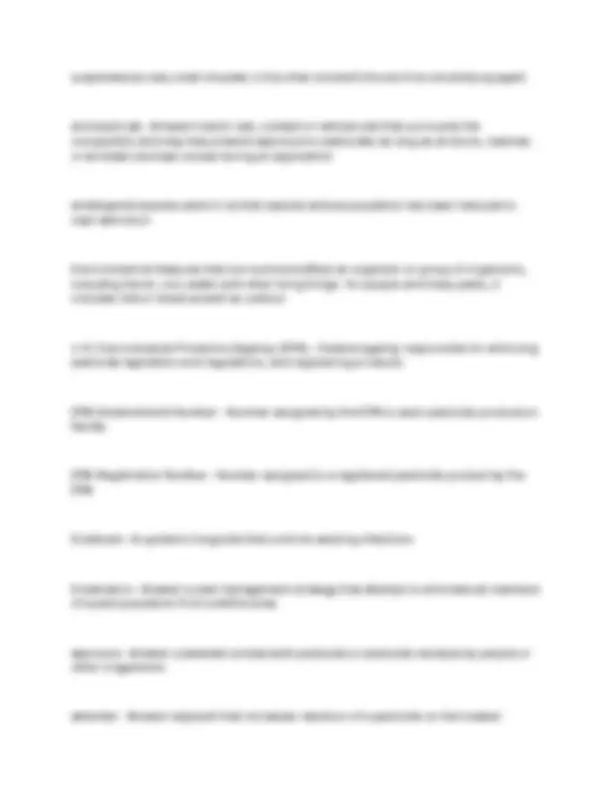


Study with the several resources on Docsity

Earn points by helping other students or get them with a premium plan


Prepare for your exams
Study with the several resources on Docsity

Earn points to download
Earn points by helping other students or get them with a premium plan
Community
Ask the community for help and clear up your study doubts
Discover the best universities in your country according to Docsity users
Free resources
Download our free guides on studying techniques, anxiety management strategies, and thesis advice from Docsity tutors
A comprehensive list of questions and answers related to the massachusetts pesticide license exam for the years 2024-2025. It covers a wide range of topics, including pesticide types (acaricides, algaecides, bactericides, avicides), pesticide properties (acidic, alkaline), application techniques (band application, basal application, broadcast application), and safety measures (antidotes, antisiphoning devices). The document also includes definitions of key terms such as active ingredient, adjuvant, bioaccumulation, and calibration, making it a valuable resource for exam preparation. It further explains the effects of pesticides, such as acute and chronic toxicity, and discusses important concepts like biological control and chemical degradation. This guide is designed to help applicators understand and apply pesticides safely and effectively, ensuring compliance with regulations and promoting environmental stewardship.
Typology: Exams
1 / 11

This page cannot be seen from the preview
Don't miss anything!







absorption - Answer the movement of a chemical into plants, animals (including humans), microorganisms or soil
Acaricide - Answer a pesticide used to control mites and ticks. a Miticide is a type of acaricide
Acidic - Answer having a ph less than 7
Acidifiers = Buffers - Answer adjuvants used to retard chemical degradation of pesticides in the spray tank by lowering the pH of alkaline water used as a diluent
Threshold of Action - React to a predetermined level of pest infestation or damage at which some type of pest management action must be taken
Activated Charcoal - React A finely ground charcoal that adsorbs chemicals.
Active Ingredient (AI) - React The chemical or chemicals in a product responsible for pesticidal activity.
Acute effect - React a symptom, illness, or injury that occurs shortly after the exposure to a pesticide
Acute Exposure An exposure to a single dose of pesticide
Acute Rodenticide A pesticide capable of killing a rodent after a single feeding
Acute Toxicity The ability of pesticide to cause illness after a single exposure. LD50 and LC50 are common indicators of the degree of acute toxicity
Adjuvant (Additive) A chemical added to a pesticide to improve its application or effectiveness, or its safety to the applicator
Adsorption Physical or chemical attraction that causes chemicals to attach to a surface.
Adulterated Pesticide A pesticide which does not meet the professed standard or quality as reflected in its label or labeling
Aerosol A liquid formulation that produces a mist or fog when applied from a container in which it is held under pressure or from a fog generating machine
Agitation The process of stirring or mixing the contents of a spray tank
Air-blast sprayer - Answer a category of pesticide application equipment that depends on a large volume of high-velocity air to atomize and distribute spray droplets from the nozzles
Algae - Answer relatively simple plants that contain chlorophyll and are photosynthetic
Algaecide (algicide) - Answer a pesticide specifically used to kill or inhibit algae
Alkaline - Answer having a pH greater than 7, als
Allergic Effects- Answer a hypersensitivity to a specific substance which is not due to the substance's toxicity
avicide Answer a chemical pesticide used to kill or repel birds
Back-siphoning Answer the movement of a pesticide mixture from a spray tank through the filling hose into the water source
Bacteria Answer a single-celled organisms; some causes diseases in plants and animals
Bactericide Answer a chemical pesticide used to control bacteria
bait -1. a food or other substance used to entice a pest into coming into contact with a pesticide or a trap. 2. a ready-to-use pesticide formulation containing an active ingredient combined with food or another attractive substance
band application an application of a pesticide or other material in or beside a crop row rather than broadcast over an entire field
basal application - Answer an application to plant stems or trunks at or just above the ground line
beneficial insect - Answer an insect that is useful to us ex: pollinators, predators of pests
Biennial - Answer a plant that completes its life cycle in two years
Bioaccumulation - Answer the process by which organisms accumulate or store chemicals in their tissues
biological control - Answer the control of pests using predators, parasites and disease-causing organisms
Biomagnification - Answer the process whereby some organisms accumulate chemical residues in higher concentration than those found in the organisms they consume
Biopesticide - Answer a pesticide derived from naturally occurring materials
Boom - Answer a pipe that is attached to a sprayer and that has nozzles spaced along its length
brand name - The specific name under which a registered pesticide product is sold
broadcast application - The application of pesticide uniformly over an entire field or area
broadleaves - Herbaceous plants with broad, rounded or flattened leaves with netted veins and two cotyledons (seed leaves). Examples include dandelions, lambdsquarters and morning glory
broad0spectrum pesticide - Answer a pesticide that is effective against a wide range of pests; also called non-selective pesticide
bulk pesticide - Answer pesticide held in containers that hold more than 55 gallons of liquid or 100 pounds of dry material
calibration - Answer the measurement and adjustment of the delivery rate of application equipment so as to apply the correct amount of material uniformly to the target area
carbamates - Answer a group of cholinesterase-inhibiting pesticides used to control insects, mites and nematodes
Carcinogen - Answer a substance or agent able to produce malignant tumors (caner)
carrier - Answer 1. an inert liquid, solid or gas added to an active ingredient to make a pesticide formulation. 2. the material, usually water or oil, used to dilute the formulated product for application
compatibility agent - Answer an adjuvant used to improve the mixing of two or more pesticide products
compatible - Answer said of two or more pesticides products that can be mixed together uniformly and without adversely affecting the effectiveness or properties of any of the products
concentrate - Answer undiluted pesticide product
concentration - Answer the amount of active ingredient in a givevn volume or weight of formulated product
contact effects - injury at the point at which pesticide exposure occurs (ex: skin irritation)
contact pesticide - any pesticide that controls pest organisms upon contact
containment pad - an impermeable pad used for mixing and loading pesticides and cleaning equipment that is designated to catch spills, leaks, overflows and wash water fro reuse or disposal
corrosive poison a substance containing a strong acid or base which will severely burn the skin, mouth, stomach or respiratory tract
cotyledon seed leaf appearing shortly after seed germinates
crack-and-crevice application small amount applied to cracks and crevices of buildings such as along baseboards and inside cabinets
cross contamination when one pesticide unintentionally becomes mixed with another
cross resistance - Question the ability of a pest population which is resistant to one pesticide to be resistant to other pesticides having a similar mode of action
danger - Question the signal word associated with pesticide products classified as highly toxic solely because they are corrosive or highly irritating to skin and eyes
danger-poison - The signal word for pesticide products that are highly toxic with low LD 50 and LC 50 values. The products may also be corrosive or cause severe irritation to skin and eyes decontaminate - To remove or break down a chemical residue from skin or surface defoaming agent - An adjuvant which is used to reduce foam formation of a spray mixture caused by agitation
defoliant - Answer a chemical that induces the premature shedding of leaves, often as an aid in the mechanical gathering of a crop
degradation - Answer 1. the process by which a chemical compound is broken down to a simpler compounds by action of microorganisms, water, air, sunlight or other agents
delayed effects- Answer illnesses or injuries that commonly occur between 24 hours and several days following pesticide exposure deposit - Answer the pesticide present on a treated surface following application dermal - Answer relating to the skin dermal toxicity - Answer the potential of a pesticide to cause injury or poisoning by being absorbed through the skin
dermatitis - the inflammation, itching, irritaiton or occurrence of a rash following exposure to a chemical
desiccant - 1. a pesticide that causes loss of moisture from leaves or other plant parts 2. a pesticide that dehydrates arthropods or destroys the waxy covering that prevents water loss
diagnosis - the positive identification of a problem and its cause
dicot - Answer a herbaceous plant which possesses two cotyledons(seed leaves) upon germination
directed-spray application - Answer an application directed to the exact site of pest occurrence, rather than to a more general area, for example, basal application to woody plants, or crack and crevice treatment in buildings
suspended as very small droplets in the other and with the aid of an emulsifying agent
enclosed cab - Answer tractor cab, cockpit or vehicle cab that surrounds the occupant(s) and may help prevent exposure to pesticides as long as all doors, hatches or windows are kept closed during an application
endangered species plant or animal species whose population has been reduced to near extinction
Environment all features that surround and affect an organism or group of organisms, including the air, soil, water and other living things. for people and many pests, it includes indoor areas as well as outdoor.
U.S. Environmental Protection Agency (EPA) - Federal agency responsible for enforcing pesticide legislation and regulations, and registering products
EPA Establishment Number - Number assigned by the EPA to each pesticide production facility
EPA Registration Number - Number assigned to a registered pesticide product by the EPA
Eradicant - A systemic fungicide that controls existing infections
Eradication - Answer a pest management strategy that attemps to eliminate all members of a pest population from a define area
exposure - Answer unwanted contact with pesticide or pesticide residues by people or other oraganisms
extender - Answer adjuvant that increases retention of a pesticide on the treated
surface by slowing evaporation and inhibiting photodegradation
FIFRA - Answer Federal Insecticide, Fungicide, and Rodenticide Act ,the primary federal pesticide law
Flowable (F or L) - Answer a pesticide formulation in which very finely ground solid particles, composed of both active and inert ingredients, are suspended in a liquid carrier
foaming agent - Answer an adjuvant designed to reduce pesticide drift by producing a thick foam
fog treament - Answer the application of a pesticide as a fine mist or fog
foliar - Answer refers to pesticide applications to the leaves of plants
food chain - Answer sequence of species within an ecological community, each member of which serves as a good source for the species next higher in the chain
formulation - Answer the pesticide product as purchased, containing one or more active ingredients combined with carriers, additives and other inert ingredients for safety and ease of application
freshening interval - Answer the least number of days that must elapse between the treatment of a nonlactating dairy animal with a pesticide and the time when the animal begins to produce milk for human consumption
fumigant - Answer a pesticide that forms vapors or gases toxic to plants, animals and microorganisms